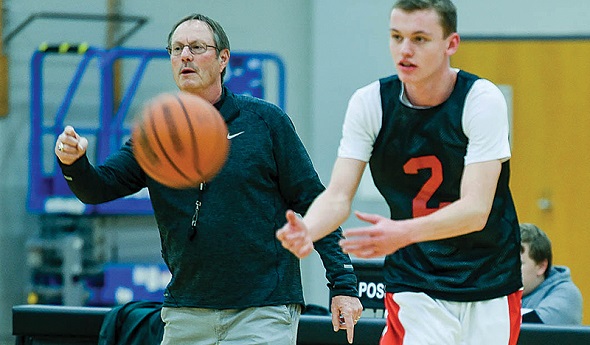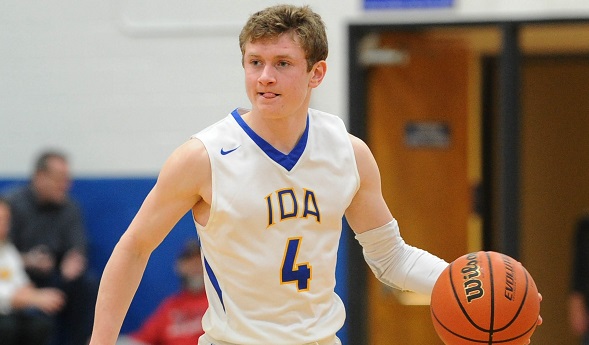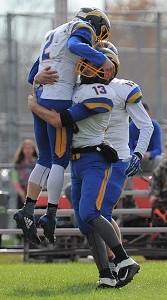
Detroit 'Longtime' Boys Coaches Down to Few
By
Tom Markowski
Special for Second Half
December 14, 2016
Gary Fralick considers himself one of the fortunate ones.
 Fralick, 66, is in his 32nd season as a head boys basketball coach. He retired from his teaching position in 2013. He started coaching at Redford Thurston in 1979, went to Royal Oak Kimball in 1984 and is in 23rd season as the head coach at Troy.
Fralick, 66, is in his 32nd season as a head boys basketball coach. He retired from his teaching position in 2013. He started coaching at Redford Thurston in 1979, went to Royal Oak Kimball in 1984 and is in 23rd season as the head coach at Troy.
Fralick might be lucky, but he is unquestionably rare. Fralick is believed to be one of three coaches in the Macomb/Oakland/Wayne area who has coached for more than 30 seasons.
There’s Dan Fife at Clarkston and Kevin Voss of Clinton Township Chippewa Valley, both of whom in their 35th seasons, all at the same school.
Another, Greg Esler at Warren DeLaSalle, is in his 30th season. He was the head coach at St. Clair Shores Lake Shore for seven seasons before going to DeLaSalle in 1994.
“We’re part of a dying breed,” Voss said.
It certainly appears so. Coaching longevity has taken on a different meaning recently. Twenty seems like a lot in these times, and in reality it is a long time. Twenty years or so ago, 20 years was normal. There’s a new normal, and 20 or 25 years isn’t it.
Many factors have contributed to this change. A person’s personal and family life often don’t coincide with the demands of coaching basketball. The responsibilities that come with coaching have increased. Some coaches say that to be an effective coach, it can be a 10- or 11-month job.
Two factors are at the forefront, and they are both financial. Coaches used to be educators as well as coaches. Yes, coaching can be viewed as teaching on the court, but at one time teaching in a classroom and coaching used to go hand in hand.
 Then there’s the subsidy coaches receive. It varies from school district to school district. Some make $4,000 a season, others can make $7,000. And it also costs money to run a program; unless the coach receives financial help from a booster club or parents, the money he or she receives begins to dwindle.
Then there’s the subsidy coaches receive. It varies from school district to school district. Some make $4,000 a season, others can make $7,000. And it also costs money to run a program; unless the coach receives financial help from a booster club or parents, the money he or she receives begins to dwindle.
But the most important factor is time.
“A tremendous amount of time is devoted to watching DVD or tapes,” Fralick said. “I know I’m dating myself with saying that. The point is, you’re watching a lot. There’s more scouting. And you don’t get paid much. Why don’t they stay as long as they used to? They get burned out. They want to spend more time with their families.
“You don’t see as many of the young coaches stay. Coaches don’t have the ambition to coach a long time. It’s not a profitable job. I don’t know what other coaches make. We used to compare what we made. Not anymore.
“Thirty years or more? I don’t see it happening. There’s the dual job thing. Things have changed. To me, it’s been a great job.”
To compensate for being away from home, Fralick brought his family with him. Sort of. He coached his son Gary, Jr., and Tim. Gary, a 1996 Troy graduate, played for his father his junior and senior seasons and Tim, a 1999 graduate, played four seasons on varsity. Fralick said he was even more fortunate to coach both on the same team (during the 1995-96 season).
Then there’s his wife, Sharon, who remains the scorekeeper.
“I’ve always had a passion for coaching and teaching,” Fralick said. “I love the game of basketball. I love the kids. There’s never a dull moment. It’s been a great ride.”
Vito Jordan has been around basketball all of his life. His father, Venias Jordan, was the boys head varsity coach at Detroit Mackenzie and Detroit Mumford before stepping down as a head coach only to return to the bench assisting his son the last six seasons.
Vito Jordan, 31, became a head coach at Detroit Osborn when he was 24. He started his coaching career the year before as an assistant to Henry Washington at Macomb College. Jordan went to Detroit Community after one season at Osborn and guided Community to its only MHSAA Finals appearance (Class B, 2013). He’s now in his fourth season as the head coach at Detroit Renaissance.
“I followed my father all of my life,” Jordan said. “I knew what I wanted to do when I was in college (Alma College). This is what I want to do the rest of my life.”
It’s different in Detroit. Schools close. Job titles change. Jordan, for instance, teaches at the Academy of Warren, a middle school in Detroit. It’s a charter school, not within the Detroit Public School system, therefore he receives his pay from two separate school systems (Renaissance is in the DPS).
There is a distinction. In some school systems coaches will receive a percentage – let’s say for argument sake, 10 percent – of their teaching salary to coach. Let’s say a person makes $60,000 a year to teach. He or she would then receive $6,000 to coach. If you coach two sports, that’s $12,000.
 Jordan is not privy to such a contract. Each job is separate. Jordan loves to coach, and he understands he must be a teacher to earn a decent living, and he’s content to continue on the path he is following. But he also knows that to make a good salary just coaching one must move on to the collegiate level like others have done.
Jordan is not privy to such a contract. Each job is separate. Jordan loves to coach, and he understands he must be a teacher to earn a decent living, and he’s content to continue on the path he is following. But he also knows that to make a good salary just coaching one must move on to the collegiate level like others have done.
“When there were coaches like my dad, Perry Watson (Detroit Southwestern), Johnny Goston (Detroit Pershing) and others, they all worked in the (Detroit Public) school system. Everyone was teaching. That was your career. None of them had aspirations of being a college coach. Not even Watson. Now everyone isn’t in the teaching profession. Maybe they do have a degree and maybe they don’t. The point is, most aren’t teachers. I can count on one hand those (in Detroit) who have their teaching certificate and coach.”
Jordan noted such successful PSL coaches like Derrick McDowell, Steve Hall and Robert Murphy who left high school to pursue a coaching career in college. Murphy guided Detroit Crockett to the Class B title in 2001 and is now the head coach at Eastern Michigan. McDowell has had two stints as a collegiate assistant coach, most recently at EMU. He’s since returned to coach at Detroit Western. Hall coached Detroit Rogers to three consecutive Class D titles (2003-05) before going to Duquesne University and Youngstown State as an assistant coach. Hall returned to Detroit last season and is in his second season as head coach at Detroit Cass Tech.
Jordan said they left high school to challenge themselves professionally, among other considerations. Voss said there are variables that influence how long a person lasts, in one school district or in coaching in general, that didn’t exist 20 years ago.
“Athletics have become pervasive in high school,” he said. “The whole booster situation you find in college is here. You can be winning but not winning enough. It’s a trickle down affect.
“Coaches complain about parents. Parents complain about playing time. High school sports is not as pure as it once was. Winning is way more important now. Now a coach comes in with a three-year window. You can have one or two down years, and the third you’d better win.
“Then there’s the pressure on your family. I’ve been lucky. My wife and I have had the players over for team dinners. We create a family atmosphere. It’s a change of society. I don’t envy the young coaches coming in.”
Community involvement has always been a priority for Voss. To keep a hand on the pulse, Voss heads the elementary basketball program within the Chippewa Valley school district. Games are held on Saturdays, and approximately 750 students take part.
“You have to have the right fit,” he said. “I’m in the right spot. You coach for different reasons when you get older. I’m enjoying the game. There’s a different level of satisfaction.”
 Tom Markowski is a columnist and directs website coverage for the State Champs! Sports Network. He previously covered primarily high school sports for the The Detroit News from 1984-2014, focusing on the Detroit area and contributing to statewide coverage of football and basketball. Contact him at [email protected] with story ideas for Oakland, Macomb and Wayne counties.
Tom Markowski is a columnist and directs website coverage for the State Champs! Sports Network. He previously covered primarily high school sports for the The Detroit News from 1984-2014, focusing on the Detroit area and contributing to statewide coverage of football and basketball. Contact him at [email protected] with story ideas for Oakland, Macomb and Wayne counties.
PHOTOS: (Top) Troy boys basketball coach Gary Fralick, left, is in his 32nd season coaching. (Middle) Detroit Renaissance boys coach Vito Jordan is following in the coaching footsteps of his father, Venias. (Below) Chippewa Valley boys coach Kevin Voss, left, is in his 35th season at his school. (Top and below photos courtesy of C&G Newspapers; middle photo courtesy of Detroit Public School League.)

Sampson Goes 'All Out' for 3 Ida Teams
April 23, 2019
By Doug Donnelly
Special for Second Half
IDA – Clay Sampson knows only one speed, whether it’s on the football field, basketball court or baseball diamond – it’s full go, all the time.
 “He has such a passion for the game, no matter what sport,” said his basketball coach, Jared Janssen. “As a coach, you preach all the time about giving it your all for 32 minutes. The thing is, with Clay, he did it. He was always going all out.”
“He has such a passion for the game, no matter what sport,” said his basketball coach, Jared Janssen. “As a coach, you preach all the time about giving it your all for 32 minutes. The thing is, with Clay, he did it. He was always going all out.”
Sampson’s career at Ida High School is winding down, and Bluestreak fans will be sad when he’s no longer putting on a uniform and representing the Class B Monroe County school.
Sports always have been part of his life. His parents were both multiple-sport athletes in high school, as was his older brother, now 21. His younger brother, 15, is following in the same footsteps.
“I played four sports when I was younger,” said Sampson, who is about 5-foot-7, 145 pounds. “I think that’s where it started. I’ve always loved the competition.”
His parents have a deep sports background as well. His mom, Carrie, was a three-sport athlete at Ida and part of the Bluestreaks’ Class C championship softball team in 1989. His dad, Steve, was a Class C champion hurdler and record holder for the Summerfield track & field team in 1990.
“He’s the middle boy of three, and he’s probably our spitfire,” said his mom. “He’s a competitor. He’s a debater, too. I’m sure his teachers would say that. He’s always up for a challenge. He’s always been an intense kid.”
In football, Sampson was Ida’s quarterback, helping the Bluestreaks win 16 games over the past two seasons and extend their consecutive playoff streak to six. He threw for more than 500 yards and ran for more than 400.
“As a mom, I was like, ‘Oh my gosh, I don’t know about him playing quarterback,’ but he just said, ‘Mom, I’m fine,’” said Carrie.
He’s been a four-year varsity baseball player. As a freshman, he drove in the winning run as Ida won the first District baseball title in school history.
Sampson made his biggest impact on the basketball court. He finished this winter as one of the top scorers in Monroe County at 20 points a game and, despite being Ida’s point guard, was third in the county in rebounding at more than seven boards a game. His shooting has improved every season, he said, and this year he made 44 3-pointers. He also knew how to draw a foul. He got to the free throw line 178 times, shooting better than 74 percent from the stripe.
“I was a sad 3-point shooter as a freshman,” Sampson said. “It’s something I worked on all through high school. This year I was better at it. I was able to use my ability to shoot from outside to draw defenders and get to the free throw line. I didn’t go out there and just chuck up 30 shots or something.
 “Coach Janssen sat down with me before the season and told me that we needed a lot of scoring out of me. I knew I had to carry that load.”
“Coach Janssen sat down with me before the season and told me that we needed a lot of scoring out of me. I knew I had to carry that load.”
Ida went just 1-20 during Sampson’s sophomore season but improved to nine wins the following year. This season, Janssen’s first, the Bluestreaks won 12 games, including back-to-back over Flat Rock and Carleton Airport, two of the three teams that shared the Huron League championship. The second of those wins, against Airport, gave Ida the District title. Sampson scored 28 in that game, including drilling 14 of 19 free throws.
“We started 0-2, but things changed after that,” Sampson said. “We had a lot of fun. No one expected us to win that many games or a District. It was great beating Dundee twice. I know my senior class had never done that, so that was awesome. Winning a District just put a great cap on the season.”
Sampson rarely came off the floor for Ida.
“A lot of people that play that way try and do too much,” Janssen said. “He always seemed to find that good medium. Everything he did helped the team, offensively and defensively. The pace he played at wasn’t too much.”
Sampson, who recently announced he would attend Glen Oaks Community College in Centreville and play basketball, said his parents never pushed sports on him or his brothers. He played in the recreation baseball leagues at Ida beginning in first grade and youth football through the community-sponsored team. He played on travel basketball teams from the time he was 10 years old.
“They introduced sports to me and my siblings, and it’s just always been part of our lives,” he said. “I couldn’t imagine not playing all of the sports that I played in. I don’t understand kids that just play one sport.
“Football is the No. 1 sport that shapes you. It’s a demanding sport. You have to be mentally and physically tough to go through a football season, let alone four. Basketball is probably my favorite, but football is a close second.”
No matter what sport Sampson plays, his family is a big part of it. In addition to his parents being at every game, his aunt, Connie Diesing, has been a strong supporter, sending texts before just about every game and being part of the community following his every play.
“I don’t think she’s ever missed a game,” Sampson said of his aunt.
Sampson is a Bluestreak through and through. The family lives in the house his grandfather grew up in.
“I think my mom is a little more competitive than my dad,” he said. “We joke about them winning state championships or holding records. It’s all in fun. My whole family is so supportive. It’s always reassuring that they have been there the whole time.”
 Doug Donnelly has served as a sports and news reporter and city editor over 25 years, writing for the Daily Chief-Union in Upper Sandusky, Ohio from 1992-1995, the Monroe Evening News from 1995-2012 and the Adrian Daily Telegram since 2013. He's also written a book on high school basketball in Monroe County and compiles record books for various schools in southeast Michigan. E-mail him at [email protected] with story ideas for Jackson, Washtenaw, Hillsdale, Lenawee and Monroe counties.
Doug Donnelly has served as a sports and news reporter and city editor over 25 years, writing for the Daily Chief-Union in Upper Sandusky, Ohio from 1992-1995, the Monroe Evening News from 1995-2012 and the Adrian Daily Telegram since 2013. He's also written a book on high school basketball in Monroe County and compiles record books for various schools in southeast Michigan. E-mail him at [email protected] with story ideas for Jackson, Washtenaw, Hillsdale, Lenawee and Monroe counties.
PHOTOS: (Top) Ida’s Clay Sampson directs this offense this winter. (Middle) Sampson (2) is hoisted by a teammate during a playoff win over Dearborn Heights Robichaud on Oct. 26. (Top photo by David E. Phillips; middle courtesy of the Ida football program.)

